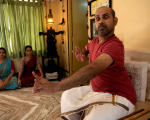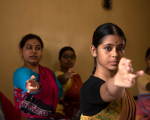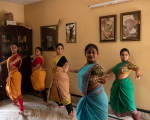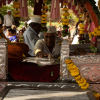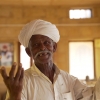Uttarpara, as the name suggests, is located uttar (north) of Bally, around 12 km from Howrah, on the west bank of the river Hooghly, and location of Parampara Institute of Dance, established by Sri Rajdeep Banerjee, an exponent of Bharatanatyam and recipient of Rajya Sangeet Academy Award. I have often visited Parampara, drawn by my interest in the classical dance forms and performing arts. Over the years, I have become familiar with the students (both senior and junior), Rajdeep Sir and his family (his mother, Mrs Sumana Banerjee, and his father, Mr Tarun Banerjee). Sumanaji is now retired, and she prefers to involve herself as a passive learner during the dance classes held by her son in the living room of their home.
The living room at Parampara is sacred, adorned by portraits of Kabiguru Rabindranath Tagore and a garlanded idol of Lord Ganesha and Lord Shiva as Nataraja. This room is the space where the guru–shishya (teacher–student) parampara (succession) is established between Rajdeep sir and his students. In India, the student learns at the feet of the teacher, reflected in the ancient Sanskrit texts of Hindu philosophy such as the Upanishads (combination of upa ‘by’ and ni+ ṣad ‘sit down’), loosely translated as ‘sitting down near’, meaning, the student sitting down near the teacher while receiving spiritual knowledge. This knowledge is passed down through generations of guru–shishyas in an unbroken chain, thus establishing a parampara. This pedagogy, typically Indian in nature and origin, has sustained many intangible heritage and cultural traditions of India. Indian classical dance is one of them.
Rajdeep Sir was initiated in Bharatanatyam as an apprentice under Srimati Pushpa Chatterjee. He then trained under Srimati Ganga Thampi, who played a major role in developing the Kalakshetra style. Currently, he is under the guidance of Sri C.V. Chandrasekhar, an accomplished Bharatanatyam dancer, dance scholar, composer and choreographer. With an intention to popularise Bharatanatyam in Bengali culture, Rajdeep Sir established Parampara in 2005. His dream is not only to encourage young dancers to embrace Bharatanatyam as performance art but also make it a career option and means to a balanced lifestyle.
Rooted to his Indian culture, Rajdeep Sir had conceptualised Parampara like a gurukul, an ashram where guru–shishya share the same ecosystem and knowledge is transferred via a symbiotic relationship between them. Though most students are day scholars and travel from their home, Parampara provides domestic facilities to outstation students. At Parampara, there is no upper age limit for admission, however the minimum age for enrolment is five years. Seniority is not based on age but skill and experience. Young students are trained and mentored by seniors. They also have a small collection of books where students can gain theoretical knowledge about various classical dance forms. With an intention to spread Bharatanatyam within the greater Bengali culture, students from Bangladesh are also learning at Parampara through exchange programmes. Occasionally, Rajdeep Sir travels to Bangladesh to conduct workshops.
However, with the onset of the Covid-19 pandemic, things changed drastically. The rhythmic sound of ghungroos and thumping of feet in Rajdeep Sir’s living room fell silent. All classes had to be cancelled and on-stage performances postponed. The live classes were replaced with video lessons. His students had been replaced by a laptop. Rajdeep Sir was utterly disappointed with this new system of online pedagogy, ‘A guru and his/her shishya must live and breathe together in the same place. Otherwise, a class will generate only information, not an elevated learning experience. You cannot replace the role of the guru with Google. This is completely against the philosophy of any guru–shishya parampara.’
However, things improved once lockdown was partially lifted and students returned. To ensure safety, all pandemic protocols laid down by the government was followed. Every student was admitted only after temperature check, and the use of face mask and hand sanitizers were made compulsory. With limited space available at Parampara, maintaining social distancing was a bigger challenge. They shifted classes to the open roof. Neighbours who share the same terrace would gather on the rooftop to watch their practice sessions. One of them recalls, ‘Watching Rajdeep and his students perform on the roof was one of the few good things that happened during this pandemic!’
Adjustments had to be done even for examinations, which are conducted by Bangiya Sangeet Parishad. Under usual circumstances, the examination is done live, but due to lockdown candidates were allowed to give online examination from their home. An admit card was issued to each student, setting a date for the online performance. However, even though students get to perform in the informal environment of their home, aharyam pertaining to Bharatanatyam are to be maintained. ‘The Aharyam should be appropriate according to the character being portrayed.’ Jewellery, costume, colour of make-up, stage props, accessories, floral decorations, all form part of aharyam. For the latter, a floral rangoli must be made on the floor. The students worked on the decor with great enthusiasm.
The pandemic has had a major impact on the lifestyle of everyone. Rajdeep Sir understands that for any performing art form, physical fitness is a priority, ‘If you are in good health, only then you can dance.’ Students at Parampara must develop strength, stamina, flexibility and balance through learning and practice of yoga. Before any class, Rajdeep sir makes sure that students go through 10 minutes of rigorous warm up. He himself teaches the asanas and ensures that correct posture is maintained.
Through Bharatanatyam, Rajdeep Sir has also addressed the importance of spiritual and mental health, which has come to the forefront during the pandemic. In this regard, students are provided an atmosphere of informality where everyone is free to express themselves. Rajdeep Sir mentions, ‘Art is a therapeutic movement. It nurtures our soul during these tough days of pandemic.’ He feels that the human mind needs channels of communication and creative expression during any unforeseen calamity, which can be provided through dance. As months went by, they kept their practice sessions going, on-and-off, which helped the students to cope with the stress of the pandemic. Soma, Meghabonti, Antara, Pritha and Shirsha, who have been associated with Parampara for many years, tell me, ‘Our schools are closed these days. Social interaction is minimum. We can catch up with friends only during dance class. This is why we don’t skip dance class even during the pandemic!’
Parampara artists finally got an opportunity to go on stage at a cultural event held at Science City auditorium, organised by the Ministry of Culture, Government of India, to mark Swami Vivekananda’s 158th birth anniversary, on January 12, 2021. Having been witness to their dedication to Bharatanatyam during the pandemic, it reminded me human ingenuity is like a river—life finds a way and the show must go on.
This photo-essay has been created as part of the Sahapedia Frames Photography Grant, supported by CSR funding from IndusInd Bank.


